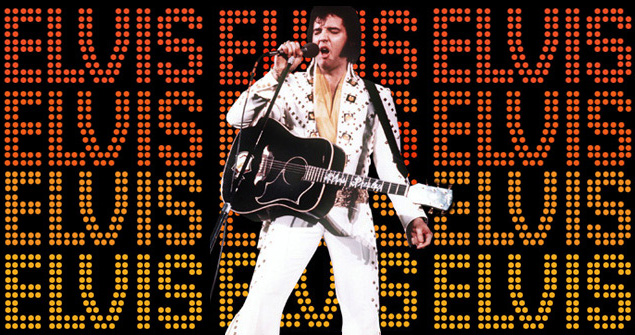Josie
Andrews
Core
Reading Response 3
March
6, 2018
In
Elvis Culture, Erika Doss explores
how and why Elvis is an American icon in contemporary culture long after his
death. Why do millions of people make,
collect, and gaze upon Elvis’s image, almost religiously, and almost 20,000
people “impersonate” him as “Elvii.”
Doss
interviewed hundreds of Elvis fans and sifted through thousands of narrative and
images, as wells social media, films, songs,
fan clubs, narratives, and even engaged in a candle light vigil at Graceland
(the second most visited American residence after the White House). Her
research evinced that Elvis’s fans play
a central role in “preserving and controlling Elvis’s history” and “revising
and redeeming his historical memory.”
In
the Reading, she discusses how Elvis’s multivalent image was carefully
constructed and controlled from the start, particularly by his manager. His enduring
popularity is attributed directly to the versatility of his image. As such, fans
give meaning to Elvis’s “multivalent image” by picking and choosing images of
Elvis and reading whatever they want into it.
In this way, fans can reconstruct Elvis into their own daily lives to
help them find public legitimacy and meaning in a society that often ignores
aspects of their own identity. It can
create a sense of belonging, while allowing individuality in belief.
In
the pictures below, I try to show visually (something Doss thinks is very
important), a few of the dominant Elvis
constructions that have been made of this American icon. Religious fans can
create shrines or create an image of Elvis’s deep faith, both male and female fans can see him as the
object of their sexual fantasy, good ‘ole white boys can see him as reasserting
their Western white masculinity and dominance, blacks can claim him for style
and his undetermined background, the working class can see him as someone
achieving the American Dream … the images created are endless.
Because this “initial” image allowed for different
meanings, posthumous attempts by Elvis
Presley Enterprises, Inc. to control
Elvis’s image often fail. Instead, in Doss’s words, returning to that original image
they gave meaning to, fans believe they can see through this corporate star-making
machinery to the “real” Elvis. And, by
creating these images or shrines of “the King,” they can keep his memory alive
as they have chosen to socially construct it.
While
I agree that his 50 million fans have created meaning at least partly from his images, I am a bit troubled that Doss largely
ignores the importance of Elvis’s songs and voice in Elvis’s American legend. I
love his music, have visited Graceland, and while not a fan club member, it is
his voice and songs that I think of when I say he is a legend. As such, I do
not think you can ignore how this long gone legend continues to speak directly
to us through his irresistible and smooth, polite Southern voice that covered tenor, baritone and an occasional bass.


Heart Throb Elvis Elvis Pelvis

Religious Elvis “Los Vega” (Big) Superstar

“Black” Elvis G.I. Elvis


“Good Dad” Elvis Generous Elvis


Cowboy Elvis And, of course, White Trash Elvis
This last image brings me to the second Reading, G. Sweeney’s
“The King of White Trash Culture: Elvis
Presley and the Aesthetics of Excess.” I thought the quote from Film director
John Waters that “White Trash” is the “last racist thing you can say and get
away with” interesting and actually went back to see the date of the article.
Trump and social media somehow missed this message of respect. But, in thinking
about this quote, I think the reason it is okay to say this “racist” statement
is because it actually reinforces the dominant white superiority culture of
mainstream American.
In another class, we discussed how by putting the
word “white” in front of trash, we imply that this is the “exception,” not the
rule for white people to be seen as poor, lazy, flashy, inappropriate and even
garish. I also thought that the use of “white”
trash shows that we don’t simply want to climb up the social ladder in America,
we need to step on some people while doing it to really feel good about
ourselves. Gore Vidal once said, “It is not enough merely to win; others must
lose.”
In thinking about the construction of star image for
“white trash” celebrities, I personally do not see Bill Clinton (who I have met
on several occasions), Elvis Presley or Dolly Parton as white trash (Roseanne
Barr, if I was going to stereotype, I might actually find her behavior a bit
off-putting in real life). While SNL (and others) might like to ridicule their
taste in clothing, food, cars and houses as a bit off from mainstream culture, I actually find it part of their personalities and charming. And, while Bill Clinton’s affairs were less than
desirable, they certainly are not a defining character of social class, as we have seen with the Weinstein and Trump fallout.
More
importantly, I think Elvis, Dolly and Bill seem to be more genuine and nice
than so many other “elite” or upper-class people I have met. As such, I would
rather spend time with them than anyone else. Obviously, a lot of other people
agree, or they would not be as popular as they are.

No comments:
Post a Comment